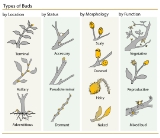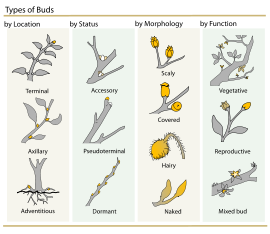
Axillary bud
Encyclopedia

Plant stem
A stem is one of two main structural axes of a vascular plant. The stem is normally divided into nodes and internodes, the nodes hold buds which grow into one or more leaves, inflorescence , conifer cones, roots, other stems etc. The internodes distance one node from another...
and petiole
Petiole (botany)
In botany, the petiole is the stalk attaching the leaf blade to the stem. The petiole usually has the same internal structure as the stem. Outgrowths appearing on each side of the petiole are called stipules. Leaves lacking a petiole are called sessile, or clasping when they partly surround the...
of a plant
Plant
Plants are living organisms belonging to the kingdom Plantae. Precise definitions of the kingdom vary, but as the term is used here, plants include familiar organisms such as trees, flowers, herbs, bushes, grasses, vines, ferns, mosses, and green algae. The group is also called green plants or...
.
As the apical meristem grows and forms leaves
Leaves
-History:Vocalist Arnar Gudjonsson was formerly the guitarist with Mower, and he was joined by Hallur Hallsson , Arnar Ólafsson , Bjarni Grímsson , and Andri Ásgrímsson . Late in 2001 they played with Emiliana Torrini and drew early praise from the New York Times...
, a region of meristematic cells are left behind at the node between the stem and the leaf. These axillary buds are usually dormant, inibited by auxin
Auxin
Auxins are a class of plant hormones with some morphogen-like characteristics. Auxins have a cardinal role in coordination of many growth and behavioral processes in the plant's life cycle and are essential for plant body development. Auxins and their role in plant growth were first described by...
produced by the apical meristem, which is known as apical dominance
Apical dominance
In plant physiology, apical dominance is the phenomenon whereby the main central stem of the plant is dominant over other side stems; on a branch the main stem of the branch is further dominant over its own side branchlets....
. If the apical meristem was removed, or has grown a sufficient distance away from an axillary bud, the axillary bud may become activated (or more appropriately freed from [hormone] inhibition). Like the apical meristem, axillary buds can develop into a stem or flower.
Certain plant diseases - notably phytoplasma
Phytoplasma
Phytoplasma are specialised bacteria that are obligate parasites of plant phloem tissue and transmitting insects . They were first discovered by scientists in 1967 and were named mycoplasma-like organisms or MLOs. They cannot be cultured in vitro in cell-free media...
s - can cause the proliferation of axillary buds, and cause plants to become bushy in appearance.
Axillary buds can be used to differentiate if the plant is single-leafed or multi-leafed. Simply count the number of leaves after an axillary bud. If there is only one leaf, then the plant is considered single-leafed, vice versa.

